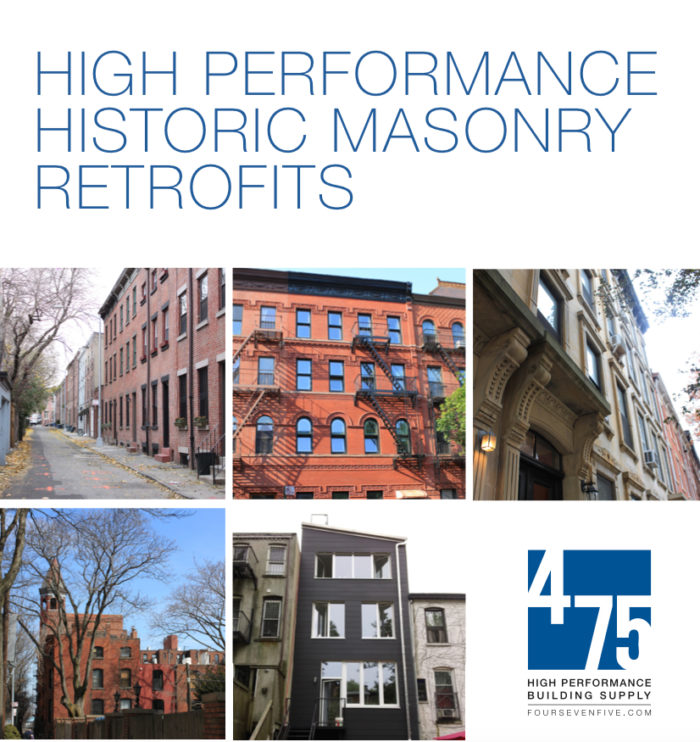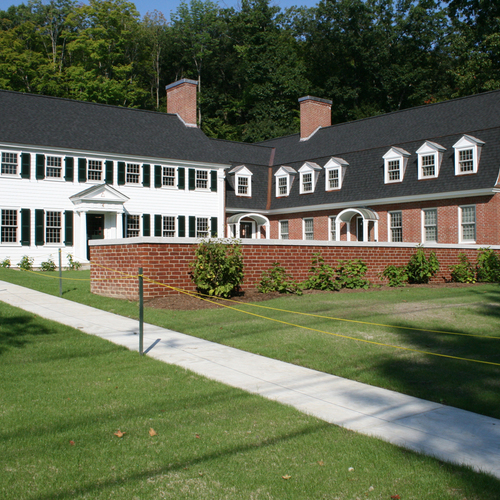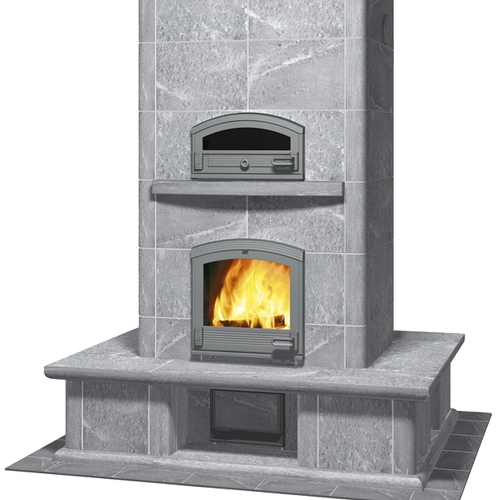
A New York City firm that specializes in materials for high-performance buildings has published an online book that explains how historic masonry buildings can be retrofitted using the products that the company sells.
High Performance Historic Masonry Retrofits is the work of 475 High Performance Building Supply, the Brooklyn-based company. Along with a number of CAD drawings, the book is available as a free download.
The book leans heavily on the core concepts of airtightness and continuous insulation that are keys to Passivhaus construction, 475 co-founder and lead author Ken Levenson said in a press release. In addition to running 475, Levenson, an architect by training, also is co-president of the North American Passive House Network and president of New York Passive House.
Other contributors include Levenson’s business partner, Floris Keverling Buisman, and two 475 employees, John Druelinger and Justin Uhr.
“The idea came about because there is a real lack of comprehensive and practical details that relate to typical conditions for high performance construction — particularly ones that don’t rely on foam insulation,” he wrote in an e-mail. “We realized that giving architects and other professionals a few simple tools could really unlock a move to much more robust detailing and execution. Of course these are meant to be just the start of the process.”
The no-foam approach
The techniques recommended in this book do not include the use of plastic foam insulation. “Foam plastic insulation dominates high-performance and green construction today, a clear victory of the power of chemical company marketing over common sense,” the book’s introduction says. “First used in buildings as roof insulation, now it too often metastasizes around our entire building enclosure.”
Despite its popularity, the authors write, foam insulation is made of dangerous ingredients and is both a fire accelerant and fire hazard. Its thermal performance degrades over time, and its performance ultimately is “unpredictable and unreliable.”
There’s another reason the authors don’t advocate the use of foam: a tenet of historic preservation is that installations be reversible. Foam isn’t.
“Admittedly, this information may cause disorientation — given the near sacrosanct position foam currently holds in the high-performance construction industry — but we can do better,” the book says. “We can do much, much better.”
Drawings can be downloaded
Drawings that appear in the book can be downloaded, also for free, allowing architects to edit and adapt them for use on their own projects. To do so, you’ll need software for CAD drawings. Levenson recommends one called DraftSight.
The book is to be the first in a series of e-books about a variety of construction types, 475 said. Each will focus on insulation, air-sealing and foam-free construction.
Hardcopies of Historic Masonry Retrofits are to be published in early 2015.
Use caution
Some recommendations in the book, such as those on insulating exterior walls, probably won’t be accepted by all building scientists. The book distributed by 475 recommends insulating thick brick walls on the interior with cellulose or fiberglass insulation — a controversial method. When asked about this approach, building scientist John Straube said, “I have qualms.”
The book notes, “Freeze-thaw damage [to bricks] … is a serious concern and needs to be fully examined before installing inboard insulation as illustrated in these pages. However, as we also note the risks can be mitigated and relatively high levels of insulation can be safely achieved. Again, it all depends. So do your homework on that, and given that freeze-thaw concerns are dealt with properly, one concern that remains, with added insulation and colder assembly surfaces, is the potential for mold growth.”
Some owners of older brick buildings have been dismayed to discover that adding interior insulation to walls resulted in severe damage to bricks. Another danger posed by interior insulation is rot to the ends of embedded joists or beams. To learn more about these issues, see the warnings in this GBA article: Insulating Old Brick Buildings.
Weekly Newsletter
Get building science and energy efficiency advice, plus special offers, in your inbox.















4 Comments
insulating brick from interior
Question: Do all these problems go away if an air gap is left between the brick wall and the insulation? In my old masonry home, an air gap is provided for by furring strips between the brick exterior walls and the plaster board. A neighbor of mine achieved a much warmer and less drafty home by injecting foam into the walls between the plaster board and brick. I once considered doing the same. Is this not wise? However tearing out the thick plaster board and plaster and putting in studs for insulation bays would be quite a job.
Response to Antonio Oliver
Antonio,
You don't want air channels near the bricks, because air channels can bring moist interior air in contact with cold bricks, encouraging condensation.
To read my advice, which differs from Ken Levenson's, see Insulating Old Brick Buildings.
Thanks Martin
But my house (and most of the houses on my street) was built (by the same builder) with those air channels 60 years ago. I always thought the gap was there to help deal with any moisture that accumulated behind the masonry. All our houses are drafty as heck except for the one with the foam. And after reading your article I guess I have to believe my neighbor did the right thing by injecting the foam. It's only about an inch of space for foam so not so much that the bricks will freeze especially at the northern edge of zone 4. But then again, the article had so many caveats it could be titled "Uhhh, Maybe." My affinity for old houses has been fading since moving into my own. In the future, I will admire them from a distance.
I love your suggested title!
Antonio,
Yes, my article could have been titled, "Uhhh, Maybe." Sometimes the truth is complicated. It makes for lousy reading, though -- I realize that.
Wouldn't it be nice if I could have just informed everyone that a single method works for all brick buildings?
Log in or create an account to post a comment.
Sign up Log in